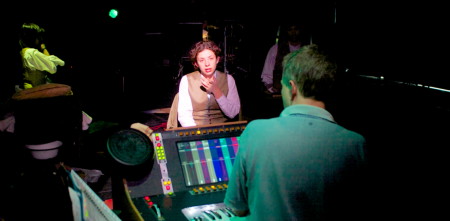

As lighting artist my input into the performance was of a different order to that of the actors, and while I could see the actors, as they could see each other, they could not see me (in the sense of my physical body) in the same way, and what they could see did not communicate what I was doing as it would when seeing another actor. The design and orientation of the Theolux console was such that the actors, from their position onstage, could see only the back of the console and for the most part they could not see what my hands were doing. The actor’s awareness of my physical presence as lighting artist was thus primarily through being able to see my eyes and face, and through their awareness of the light that I was performing through.
***
While the actors did not, for the most part, return my gaze in a literal sense, since their eyes could not generally be directed towards the operating position for any sustained period, their sensitivity to light was critical. This sensitivity arose, I would suggest, from the extended rehearsal period during which the actors had worked with me and with light in the room: one actor made the distinction between ‘working in the light’ (in a conventional process where the lighting arrives towards the end) and ‘working with the light’ (where the light has been present throughout rehearsals).
***
During the discussion following the first performance, one of the actors noted that she responded to changes in the lighting, rather than expecting the lighting to light her in a particular way in a particular time and place (as would typically be the case within conventional lighting practice). As another actor noted, this is the same as how actors work with each other in performance. This was not about the cuing of one performer by another, in the sense of a procedural process in which an action undertaken by one person is pre-agreed to be taken as the signal to act by another. While there were a small number of specifically cued events, at no point during the rehearsal process were there any of the discussions about cuing that occur extensively in a conventional process, where cues and timings are agreed (and hence pre-determined). Rather, specific sequences of events were agreed so that – where it seemed to be necessary – the order of actions was determined, but within that ordering the timing was left to the judgement of each performer.